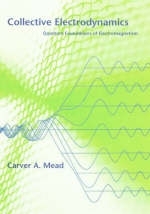
Collective Electrodynamics
Quantum Foundations of Electromagnetism
Seiten
2000
MIT Press (Verlag)
978-0-262-13378-4 (ISBN)
MIT Press (Verlag)
978-0-262-13378-4 (ISBN)
- Titel ist leider vergriffen;
keine Neuauflage - Artikel merken
In this text, a different approach to the standard problems of electromagnetic theory is offered. The book proposes the use of "collective electrodynamics", a version of electrodynamics that looks at how electrons interact through the results of direct experimentation.
In this book Carver Mead offers a radically new approach to the standard problems of electromagnetic theory. Motivated by the belief that the goal of scientific research should be the simplification and unification of knowledge, he describes a new way of doing electrodynamics - collective electrodynamics - that does not rely on Maxwell's equations, but rather uses the quantum nature of matter as its sole basis. Collective electrodynamics is a way of looking at how electrons interact, based on experiments that tell us about the electrons directly. (As Mead points out, Maxwell had no access to these experiments). The results Mead derives for standard electromagnetic problems are identical to those found in any text. Collective electrodynamics reveals, however, that quantities that we usually think of as being very different are, in fact, the same - that electromagnetic phenomena are simple and direct manifestations of quantum phenomena. Mead views his approach as a first step toward reformulating quantum concepts in a clear and comprehensible manner.
The book is divided into five sections: magnetic interaction of steady currents; propagating waves; electromagnetic energy; radiation in free space; and electromagnetic interaction of atoms. In an engaging preface, Mead tells how his approach to electromagnetic theory was inspired by his interaction with Richard Feynman.
In this book Carver Mead offers a radically new approach to the standard problems of electromagnetic theory. Motivated by the belief that the goal of scientific research should be the simplification and unification of knowledge, he describes a new way of doing electrodynamics - collective electrodynamics - that does not rely on Maxwell's equations, but rather uses the quantum nature of matter as its sole basis. Collective electrodynamics is a way of looking at how electrons interact, based on experiments that tell us about the electrons directly. (As Mead points out, Maxwell had no access to these experiments). The results Mead derives for standard electromagnetic problems are identical to those found in any text. Collective electrodynamics reveals, however, that quantities that we usually think of as being very different are, in fact, the same - that electromagnetic phenomena are simple and direct manifestations of quantum phenomena. Mead views his approach as a first step toward reformulating quantum concepts in a clear and comprehensible manner.
The book is divided into five sections: magnetic interaction of steady currents; propagating waves; electromagnetic energy; radiation in free space; and electromagnetic interaction of atoms. In an engaging preface, Mead tells how his approach to electromagnetic theory was inspired by his interaction with Richard Feynman.
| Erscheint lt. Verlag | 1.11.2000 |
|---|---|
| Zusatzinfo | Illustrations |
| Verlagsort | Cambridge, Mass. |
| Sprache | englisch |
| Maße | 152 x 229 mm |
| Gewicht | 408 g |
| Themenwelt | Naturwissenschaften ► Physik / Astronomie ► Elektrodynamik |
| Naturwissenschaften ► Physik / Astronomie ► Quantenphysik | |
| ISBN-10 | 0-262-13378-4 / 0262133784 |
| ISBN-13 | 978-0-262-13378-4 / 9780262133784 |
| Zustand | Neuware |
| Haben Sie eine Frage zum Produkt? |
Mehr entdecken
aus dem Bereich
aus dem Bereich
eine Einführung in die Gleich- und Wechselstromtechnik
Buch | Hardcover (2024)
Hanser (Verlag)
34,99 €
Grundlagen und praktische Anwendungen
Buch | Hardcover (2022)
Hanser (Verlag)
34,99 €


